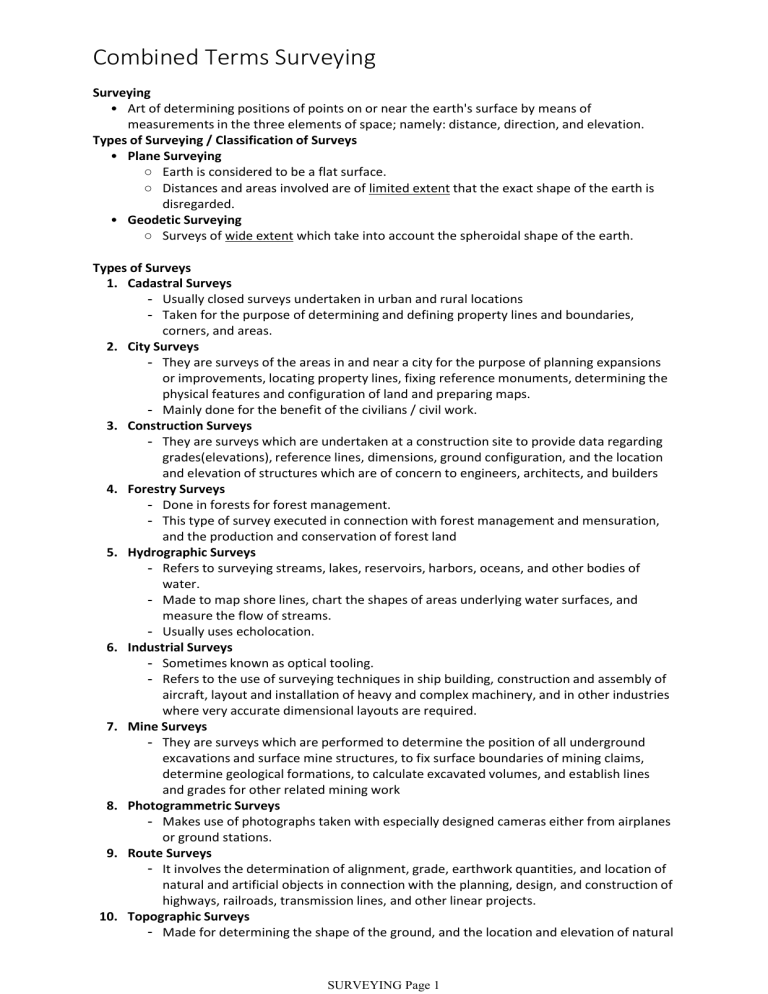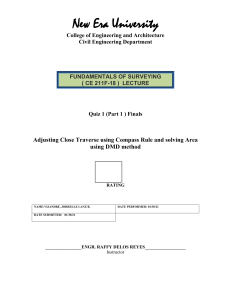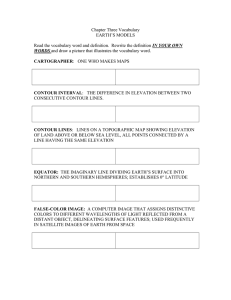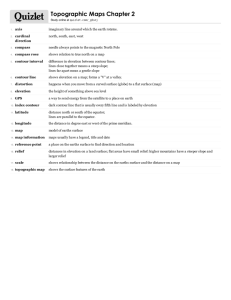
Combined Terms Surveying Surveying • Art of determining positions of points on or near the earth's surface by means of measurements in the three elements of space; namely: distance, direction, and elevation. Types of Surveying / Classification of Surveys • Plane Surveying ○ Earth is considered to be a flat surface. ○ Distances and areas involved are of limited extent that the exact shape of the earth is disregarded. • Geodetic Surveying ○ Surveys of wide extent which take into account the spheroidal shape of the earth. Types of Surveys 1. Cadastral Surveys - Usually closed surveys undertaken in urban and rural locations - Taken for the purpose of determining and defining property lines and boundaries, corners, and areas. 2. City Surveys - They are surveys of the areas in and near a city for the purpose of planning expansions or improvements, locating property lines, fixing reference monuments, determining the physical features and configuration of land and preparing maps. - Mainly done for the benefit of the civilians / civil work. 3. Construction Surveys - They are surveys which are undertaken at a construction site to provide data regarding grades(elevations), reference lines, dimensions, ground configuration, and the location and elevation of structures which are of concern to engineers, architects, and builders 4. Forestry Surveys - Done in forests for forest management. - This type of survey executed in connection with forest management and mensuration, and the production and conservation of forest land 5. Hydrographic Surveys - Refers to surveying streams, lakes, reservoirs, harbors, oceans, and other bodies of water. - Made to map shore lines, chart the shapes of areas underlying water surfaces, and measure the flow of streams. - Usually uses echolocation. 6. Industrial Surveys - Sometimes known as optical tooling. - Refers to the use of surveying techniques in ship building, construction and assembly of aircraft, layout and installation of heavy and complex machinery, and in other industries where very accurate dimensional layouts are required. 7. Mine Surveys - They are surveys which are performed to determine the position of all underground excavations and surface mine structures, to fix surface boundaries of mining claims, determine geological formations, to calculate excavated volumes, and establish lines and grades for other related mining work 8. Photogrammetric Surveys - Makes use of photographs taken with especially designed cameras either from airplanes or ground stations. 9. Route Surveys - It involves the determination of alignment, grade, earthwork quantities, and location of natural and artificial objects in connection with the planning, design, and construction of highways, railroads, transmission lines, and other linear projects. 10. Topographic Surveys - Made for determining the shape of the ground, and the location and elevation of natural and artificial features upon it. SURVEYING Page 1 and artificial features upon it. Measurement - The process of determining the extent, size, or dimensions of a particular quantity in comparison to a given standard. - Was concentrated on angles, elevations, times, lines, areas, and volumes. ** Measurements are never exact and they will always be imperfect no matter how carefully made.** **Physical measurements acquired are correct only within certain limits because errors cannot be totally eliminated.** Types of Measurement ○ Direct Measurement - A comparison of measured quantity with a standard measuring unit/s employed for measuring a quantity of that kind. ○ Indirect Measurement - The observed value is determined by the relationship to some other known values Mistakes - Inaccuracies in measurements which occur because some aspect of a surveying operation is performed by the surveyor with carelessness, inattention, poor judgement, and improper execution. Errors - Defined as the difference between the true value and the measured value of a quantity Types of Errors ○ Systematic Errors - Always has the same sign and magnitude as long as field conditions remain constant and unchanged ○ Accidental Errors - Caused by factors beyond the control of the surveyor. - Present in all surveying measurements. - Occurrences are a matter of chance as they are likely positive or negative. Sources of Errors ○ Instrumental Errors - Errors due to imperfections in the instruments either from 1. Faults in their construction or 2. From improper adjustments between the different parts prior to use. ○ Natural Errors - Caused by variations in the phenomena of nature such as changes in magnetic declination, temperature, humidity, wind, refraction, gravity, and curvature of the earth. - Beyond the control of man. ○ Personal Errors - Errors from limitations of the senses of sight, touch, and hearing of the human observer which are likely to be erroneous or inaccurate. Accuracy - Indicates how close a given measurement is to the absolute or true value of the quantity measured. - Implies the closeness between related measurements and their expectations. Precision - Refers to the degree of refinement and consistency with which any physical measurement is made. - Portrayed by the closeness to one another of a set of repeated measurements of a quantity. Deviation - Difference between any measured value of a quantity and its most probable value Probable Error - The value when added to and subtracted from the most probable value will define the range of the true value. SURVEYING Page 2 of the true value. Weighted Measurements - Measurements are made under different circumstance and conditions have different degrees of reliability. Pace - Length of a single step Pacing - Counting the number of steps in a required distance Stride - Two(2) paces Pace Factor - Determined by dividing measured length of a line by the mean no. of paces taken from the traverse of a line. Paced Distance - Length of course determined by pacing Taping - Measuring the length of a line using a tape Discrepancy - Difference between any two measurement involving the same line or course. Relative Precision of Measurement - A value determined by dividing the discrepancy by the mean measured length and the numerator is reduced to 1. Compass Surveying ○ Any line have a length and direction. ○ The length is measured by a chain or tap or any other instrument. ○ The direction is measured by a theodolite or compass. Compass - An instrument designed for the measurement of directions with reference to the magnetic meridian ○ Types of Compass: 1. Prismatic Compass 2. Surveyor's Compass ○ Parts of Compass • Magnetic Needle - The magnetic needle has a red end that points to the magnetic north, as long as the compass is being used properly and there is no local magnetic attraction. • Housing with Cardinal Points and Degrees - The housing includes a revolving dial that shows the cardinal points (at least north, east, south, and west) and degrees (0-360). - The housing is rotated to line up the compass needle with the orienting arrow when taking a bearing. • Orienting Arrow - The north-south orienting arrow (red or black outline of an arrow) is used to align the magnetic needle when taking a bearing. It is also what is adjusted to set the compass for magnetic declination. • Orienting Lines - The north-south orienting lines parallel the orienting arrow and can be used to line up the compass dial with grid lines on a map. When the declination is set on a compass with an adjustment screw, the orienting lines no longer parallel the orienting arrow. • Index Line - Marked on the front sight of the compass base plate, the index line is where you read the indicated bearing. • Direction of Travel Arrow - The direction of travel arrow or sighting line is used for sighting the following bearings. The arrow should be pointed in the direction of the destination or landmark. SURVEYING Page 3 landmark. • Base Plate - The transparent plate can be used as a ruler to measure map distances. The direction of travel arrow is also located on the baseplate. Some compasses will have a protractor on the baseplate that can be used to determine bearings from a map. • Magnifying Lens - Useful for reading tiny map symbols and features. • Declination Adjustment Screw - Some compasses have a screw that can be turned to set compass for proper declination. Some compasses have an internal adjustment that automatically corrects for declination. • Clinometer - Some compasses have a clinometer that can be used to estimate slope. • Sighting Mirror - Some compasses have a flip up mirror that can improve accuracy when reading bearings. Read the bearing in the dial’s reflection where the mirror line crosses it. It can also be used for signaling. ○ Sources of Errors in Compass works 1. Needle Bent - If the needle is not perfectly straight, a constant error in introduced in all observed bearings. The needle can be corrected by using pliers. 2. Pivot Bent - If the point of the pivot supporting the needle is not at the center of graduated circle. 3. Plane of sight not vertical or graduated circle not horizontal 4. Sluggish 5. Reading the Needle 6. Magnetic Variations Bearing - The angle between the survey lines and the fixed line of reference with the compass. True Meridian - The true or geographical meridian passing through a point is the line in which the earth’s surface is intersected by a plane through the north and south poles and the given point. Magnetic Meridian - The direction indicated by a freely floating and properly balanced magnetic needle, and the angle between a survey line and the magnetic meridian is called the magnetic bearing Designation of Bearing 1. Whole Circle System - Angle measured from the north direction to that line clockwise direction. - Ranges from 0 to 360 degrees. - Bearing of any line is considered as the definition of the line orientation. **We refer Azimuth from South. ** 2. Quadrantal System - Measures between 0°to 90°. - Always measured from the reference meridian (either North or South) Azimuths - Angles measured clockwise from any reference meridian (South is default) - Ranges from 0 to 360° Traverse - A series of consecutive lines whose lengths and directions have been measured. Two Types of Traverse 1. Closed Traverse - Provide a check on the validity and accuracy of field measurements 2. Open Traverse - A series of measured straight lines and angles that do not close geometrically and provide no check and are not recommended. SURVEYING Page 4 provide no check and are not recommended. - Usually applied in underground surveys. Latitude of any line - The projection on a north and south lines. - It may be called as north or positive latitude, and south or negative latitude - Latitude = Distance x cos(Bearing) Departure of any line - The projection on an east and west lines. - It may be called as east or positive departure, and west or negative departure. - Departure = Distance x sin(Bearing) Linear Error of Closure (For closed traverse) - In any closed traverse, there is always an error. No survey is geometrically perfect until proper adjustments are made. - For a closed traverse, the sum of the north and south latitudes, same with the sum of east and west departure, should always be zero Compass Rule - The correction to be applied in the latitude or departure of any course is the total correction in latitude or departure multiply to the ratio length of the course is to the length of the traverse. Transit Rule - The correction to be applied in the latitude or departure of any course is the total correction in latitude or departure multiply to the magnitude of latitude or departure of that course is to the arithmetical sum of all the latitudes or departures in the traverse without regards to sign. Area Computation 1. Area by Coordinates 2. Area by Double Meridian Distance (DMD) 3. Area by Double Parallel Distance (DPD) Missing Data In a closed traverse if lengths and bearings of all lines could not be measured due to certain reasons, the omitted or the missing measurements can be computed provided the number of such omissions is not more than two. ○ In a closed Traverse, ∑ = 0 and ∑ Two Peg Test - Method for checking and recalibrating a level or transit - This method is either for an optical or digital level, or a transit being used as a level. If this error is corrected with a transit, it also improves the accuracy of its vertical angle readings. - The basic principle is that since the error in level readings results from the instrument not sighting exactly horizontally, is thus looking up or down at some angle, and that this angle is the same whichever way it's sighting: Leveling Methods 1. Differential Leveling 2. Inverse Leveling 3. Profile Leveling 4. Trigonometric Leveling 5. Reciprocal Leveling - Employed to determine the difference in elevation between two points when it is difficult or impossible to keep backsights and foresights short and equal. Bench Mark (BM) - A fixed point of reference whose elevation is either known or assumed. Backsight (BS) - A reading taken on a rod held on a point of known or assumed elevation. Foresight (FS) - A reading taken on a rod held on a point whose elevation is to be determined Backsight distance - Measured from the center of the instrument to the rod on which u backsight is taken. Foresight distance SURVEYING Page 5 Foresight distance - The horizontal distance from the center of the instrument to the rod on which a foresight is taken. Turning Point (TP) - An intervening point between two bench marks upon which point foresight and backsight rod readings are taken to enable a leveling operation to continue from a new instrument position. Triangulation - A method for extending horizontal control for topographic and similar surveys which require observations of triangular figures whose angles are measured and whose sides are determined by trigonometric computations Four Common Geometric Figures Used in Triangulation: 1. Chain of single and independent triangles. 2. Chain of quadrilaterals formed with overlapping triangles 3. Chains of polygons or central-point figure 4. Chain of polygons each with an extra diagonal Topographic Map - Also known as contour map - A map that shows the shape of the land using contour line. - A map that shows elevation field: how high and low the ground is in relation to sea level. Contour Lines - Lines that connect points that are of the same elevation - They show the exact elevation, the shape of the land, and the steepness of the land's slope. - Contour lines never touch or cross Bench mark - A point where the exact elevation is known and is marked with a brass or aluminum plate - Marked BM on the map with the elevation numbers given in feet. - Useful to help determine contour lines. Map Scale - Compares distances on the map with distances on earth. Legend - Explains symbols on the map. Index Contours - Contour lines that are labeled to help you find the contour interval. Contour Interval - The difference in elevation between two contour lines that are side by side - It is NOT the distance between two lines -- to get the distance, you need to use the map scale. About Contour Lines: • If contour lines are close together: - That area has a steep slope • If contour lines are far apart: - The land has gentle slope (low slope) - • The dark colored contour lines represent every 5th contour line to make it easier to read the map. SURVEYING Page 6 map. • Contour lines form V's that point upstream when they cross a stream. • They point in the opposite direction as the flow of water. Depressions - E.g the inside of a dead volcano - Represented by Hachure Lines Hachure Lines - Regular contour lines with small segments sticking out from it - The first hachure line is at the same elevation as the contour line before it. Representation of Colors on the topographic map: • Blue lines / shapes - Water features such as streams and lakes • Brown - Contour lines • Black - Roads, buildings, railroads, other man-made objects. • Green - Woodland areas • Red - Highways Reading a Topographic Map 1. Determine the contour interval (the distance between each contour line) 2. Determine the map scale (usually at the bottom of the map) 3. Identify any hills or depressions 4. Use the legend to identify man-made features. 5. Look for areas where the contour lines are close together – they indicate a steep area. 6. Look for areas where the contour lines are spread apart – they indicate a gentle slope. Global Positioning System (GPS) - A space-based satellite navigation system provides location and time information in all weather. - Maintained by the US government and is freely accessible by anyone with a GPS receiver - Official Name: “Navigational Satellite Timing and Ranging Global Positioning System” - Consists of 30 + GPS satellites in medium Earth orbit (2000 km – 35000 km) - Made up of two dozen satellites working in harmony are known satellite constellation - Mainly used for navigation, map-making and surveying GPS ELEMENTS 1. Space Segment - GPS satellites fly in circular orbits at an altitude of approximately 20,200 km and with period of 12 hours. - Powered by solar cells. - Orbits are designed so that at least six satellites are always within line of sight from any location on planet. 2. Control Segment - Consists of three (3) entities: i. Master Control System - The master control station, located at Falcon Air Force Base in Colorado Springs. - Responsible for overall management of the remote monitoring and transmission sites. ii. Monitor Stations - Checks the exact altitudes, position, speed, and overall health of the orbiting satellites. - Ensures that the GPS satellite orbits and clocks remain within acceptable limits. iii. Ground Antennas - Monitor and track the satellites from horizon to horizon. 3. User Segment SURVEYING Page 7 3. User Segment - GPS receivers are generally composed of: i. Antenna ii. Receiver Processors iii. Highly Stable Clock Working Geometric Principle: - You can find one’s location if you know its distance from other already known locations. Things which need to be determined: 1. Current locations of GPS Satellites 2. The distance between Receiver's position and the GPS satellites. Distance Between Receiver's Position and GPS Satellites: To get the distance to each satellite: i. By measuring the amount of time taken by radio signal (the GPS signal) to travel from the satellite to the receiver. ii. Radio waves travel at the speed of light iii. The distance from the satellite to the receiver can be determined by: = × iv. Hence receiver’s position find out using trilateration SURVEYING Page 8




